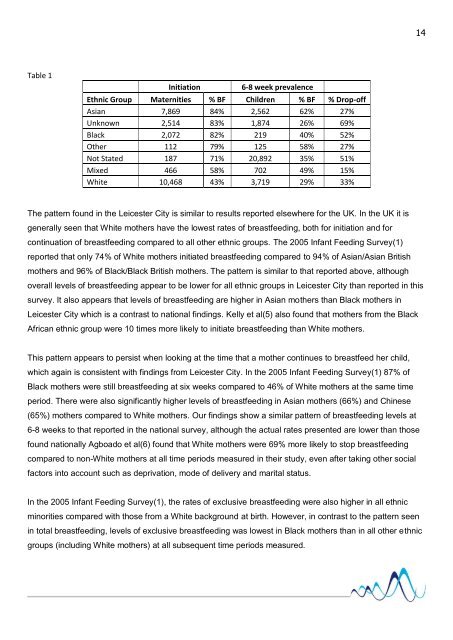Infant Feeding in Leicester City - East Midlands Public Health ...
Infant Feeding in Leicester City - East Midlands Public Health ...
Infant Feeding in Leicester City - East Midlands Public Health ...
Create successful ePaper yourself
Turn your PDF publications into a flip-book with our unique Google optimized e-Paper software.
14Table 1Initiation6-8 week prevalenceEthnic Group Maternities % BF Children % BF % Drop-offAsian 7,869 84% 2,562 62% 27%Unknown 2,514 83% 1,874 26% 69%Black 2,072 82% 219 40% 52%Other 112 79% 125 58% 27%Not Stated 187 71% 20,892 35% 51%Mixed 466 58% 702 49% 15%White 10,468 43% 3,719 29% 33%The pattern found <strong>in</strong> the <strong>Leicester</strong> <strong>City</strong> is similar to results reported elsewhere for the UK. In the UK it isgenerally seen that White mothers have the lowest rates of breastfeed<strong>in</strong>g, both for <strong>in</strong>itiation and forcont<strong>in</strong>uation of breastfeed<strong>in</strong>g compared to all other ethnic groups. The 2005 <strong>Infant</strong> <strong>Feed<strong>in</strong>g</strong> Survey(1)reported that only 74% of White mothers <strong>in</strong>itiated breastfeed<strong>in</strong>g compared to 94% of Asian/Asian Britishmothers and 96% of Black/Black British mothers. The pattern is similar to that reported above, althoughoverall levels of breastfeed<strong>in</strong>g appear to be lower for all ethnic groups <strong>in</strong> <strong>Leicester</strong> <strong>City</strong> than reported <strong>in</strong> thissurvey. It also appears that levels of breastfeed<strong>in</strong>g are higher <strong>in</strong> Asian mothers than Black mothers <strong>in</strong><strong>Leicester</strong> <strong>City</strong> which is a contrast to national f<strong>in</strong>d<strong>in</strong>gs. Kelly et al(5) also found that mothers from the BlackAfrican ethnic group were 10 times more likely to <strong>in</strong>itiate breastfeed<strong>in</strong>g than White mothers.This pattern appears to persist when look<strong>in</strong>g at the time that a mother cont<strong>in</strong>ues to breastfeed her child,which aga<strong>in</strong> is consistent with f<strong>in</strong>d<strong>in</strong>gs from <strong>Leicester</strong> <strong>City</strong>. In the 2005 <strong>Infant</strong> <strong>Feed<strong>in</strong>g</strong> Survey(1) 87% ofBlack mothers were still breastfeed<strong>in</strong>g at six weeks compared to 46% of White mothers at the same timeperiod. There were also significantly higher levels of breastfeed<strong>in</strong>g <strong>in</strong> Asian mothers (66%) and Ch<strong>in</strong>ese(65%) mothers compared to White mothers. Our f<strong>in</strong>d<strong>in</strong>gs show a similar pattern of breastfeed<strong>in</strong>g levels at6-8 weeks to that reported <strong>in</strong> the national survey, although the actual rates presented are lower than thosefound nationally Agboado et al(6) found that White mothers were 69% more likely to stop breastfeed<strong>in</strong>gcompared to non-White mothers at all time periods measured <strong>in</strong> their study, even after tak<strong>in</strong>g other socialfactors <strong>in</strong>to account such as deprivation, mode of delivery and marital status.In the 2005 <strong>Infant</strong> <strong>Feed<strong>in</strong>g</strong> Survey(1), the rates of exclusive breastfeed<strong>in</strong>g were also higher <strong>in</strong> all ethnicm<strong>in</strong>orities compared with those from a White background at birth. However, <strong>in</strong> contrast to the pattern seen<strong>in</strong> total breastfeed<strong>in</strong>g, levels of exclusive breastfeed<strong>in</strong>g was lowest <strong>in</strong> Black mothers than <strong>in</strong> all other ethnicgroups (<strong>in</strong>clud<strong>in</strong>g White mothers) at all subsequent time periods measured.


